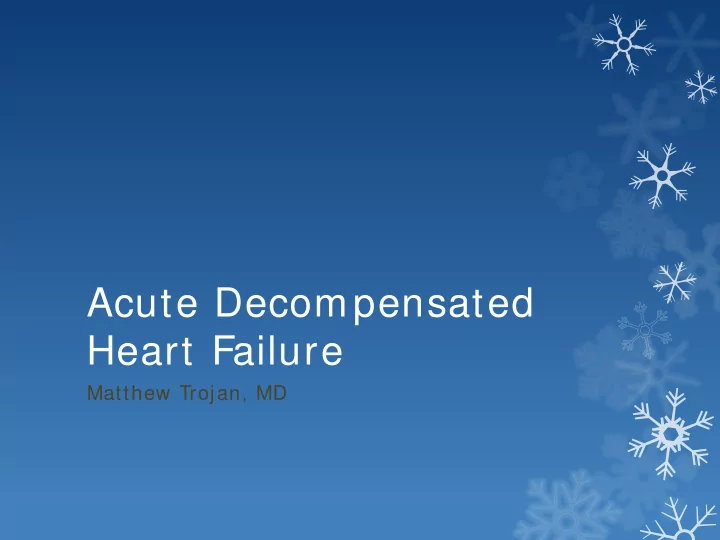

Acute Decompensated Heart Failure Matthew Trojan, MD
Disclosures Consultant, St. Jude Medical
Organization Definition of the problem Evaluation and triage Management consideration Transition to outpatient At least 25% of talk will be time for question answer, so get the questions ready I also may call on members of the audience
800 lb gorilla Acute decompensated heart failure is the leading cause of hospitalization for patients age 65 and older (1,000,000 per year) Mortality from HF is doubled for 12 months following hospitalization 10% at 30 days, 20-40% at 12 months Risk is additive 2 hospitalization= 4x risk Hospitalization and rehospitalization represents the majority of the cost of caring for HF patients ICD’s, angiography, etc vs cost of inpatient care ~ 20% readmit at 30 days, 50% at 6-12 months
Demographics Describe the average patient hospitalized for heart failure
Clinical trials for hf Exclude patients who are hypertensive Concentrate on patients with reduced EF
Triage Clinical diagnosis of signs and symptoms Routine usage BNP NOT recommended BNP should be used when clinical diagnosis is uncertain Pitfalls of BNP: renal, elderly, significant COPD, obese, hyperacute HF
Decongestion Diuretic IV dose should be greater or equal to PO dosage 40 BID does NOT equal 80 qd Gtt vs intermittent bolus
Do’s and Don’t’s Yes: pressure inotropes ventilation Daily weights Telemetry Strict I&O Daily lytes, Cr No O2 for hypoxia Routine BNP 2 gm NaCl O2 for DVT Prophy nonhypoxic Maybe Routine Fluid restrict invasive monitor Non-invasive Routine positive
Other meds If preserved EF (> 45% ) no evidence to support ACE-I or B-blocker over other therapies ACE-I and afterload and orthostasis and Cr/ GFR Compensatory tachycardia and B-blocker and fluid retention NTG, Nipride, Neseritide V= IR Spironolactone
Renal Failure Strongest predictor of ARF in renal failure: A)Cardiac output B)Pulmonary capillary wedge pressure C)Central venous pressure D)Systolic BP
Abdominal compartment syndrome Patient with HF , will admit and diurese… .evidence of intravascularly dry, will give IVF Concept of perfusion pressure 120/ 70, CVP 5= 87-5= 82 mmHg 140/ 90, CVP 20, IAP 10= 107-20-10= 76 90/ 60, CVP 25, IAP 15= 70-25-15= 30 90/ 60, CVP 5, IAP 15= 70-5-15= 50 ACE-I effect afferent, NSAID effect efferent Nephrology Associates 541 485 6478
Discharge criteria Predischarge BNP vs treat to BNP Identify and rectify precipitant Euvolemia Address revascularization Assess EF Optimize oral meds Education (tobacco, weights, edema, meds, Na, fluid) 8 glasses/ day is a No-no Admissions beget readmissions
Questions?
Recommend
More recommend